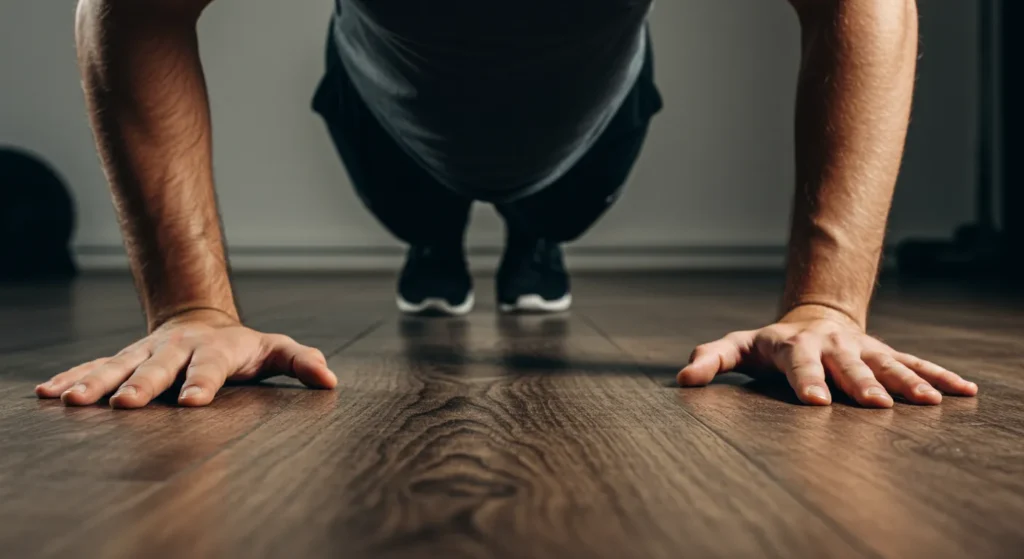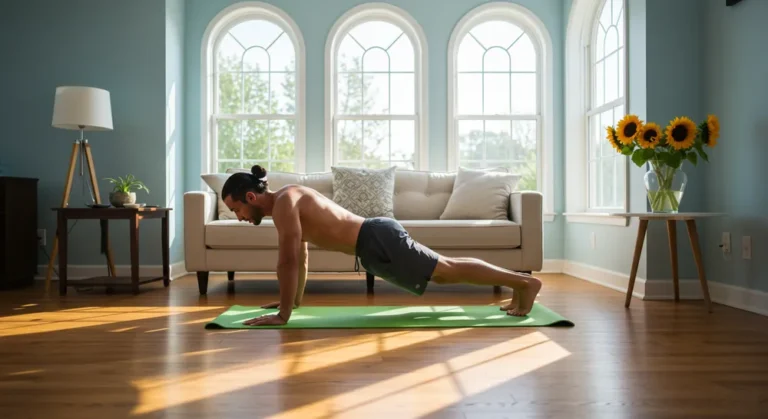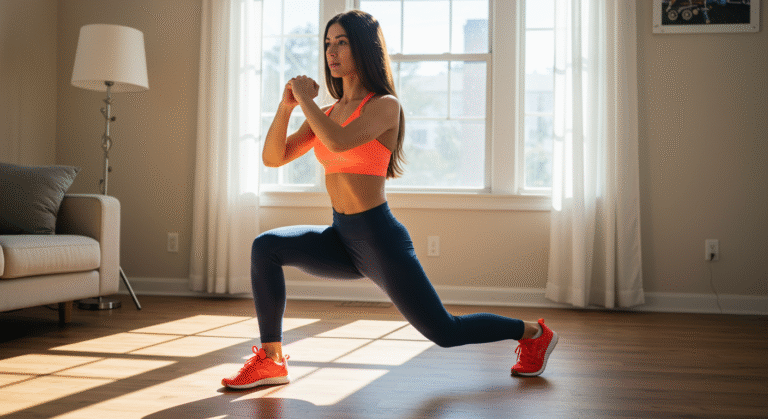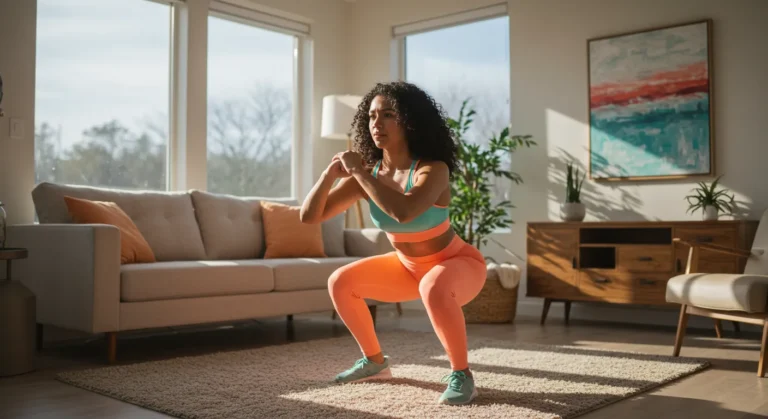Strength Training at Home: Build Muscle Without a Gym

I used to think real strength training meant hauling myself to a crowded gym, waiting for equipment, and feeling intimidated by people who looked like they’d been lifting since birth.
Then life got busy, gym memberships got expensive, and I realized something that changed everything: my living room was perfectly capable of becoming my personal strength-building sanctuary.
Here’s what nobody tells you about strength training at home—it’s not just a backup plan for when you can’t make it to the gym. For many people, it’s actually more effective than traditional gym workouts.
No waiting for machines, no judgment, no excuses about traffic or parking. Just you, some basic equipment, and the kind of consistency that actually builds lasting strength.
If you’re tired of making excuses or genuinely curious about what’s possible without a gym membership, stick around. We’re about to explore how to build real muscle, improve functional strength, and feel genuinely powerful—all from the comfort of your own space.
Why Your Living Room Might Be Better Than the Gym
Let’s address the elephant in the room: “Can you really build muscle without heavy weights and fancy machines?” The short answer is absolutely yes, and I’ll tell you why.
Your muscles don’t have gym memberships. They respond to resistance, tension, and progressive challenge—regardless of whether that comes from a $50,000 machine or your own body weight.
Some of the strongest, most functional athletes I know built their foundation using nothing more than bodyweight exercises and basic equipment.
The advantages of beginner strength training at home are pretty compelling:
- Zero commute time means more time for actual exercise
- Complete customization of your environment, music, and schedule
- Cost-effective once you have basic equipment
- Privacy to learn proper form without feeling self-conscious
- Consistency becomes much easier when your gym is always open
But here’s what really sold me: home strength training naturally emphasizes functional movement patterns.
When you’re working with limited equipment, you focus on exercises that translate to real-world activities—picking up kids, carrying groceries, moving furniture. That’s functional strength training at its finest.
Building Your Foundation: A Beginner’s Roadmap
Starting strength training at home doesn’t require a master plan or perfect equipment. It requires a simple, sustainable approach that you can stick with long enough to see real results.
Here’s a straightforward 3-day weekly structure that works:
Day 1: Lower Body Focus
Your legs are your foundation—literally and figuratively. These exercises build strength while improving everyday mobility.
- Bodyweight squats: Start with 3 sets of 8-12 reps
- Glute bridges: Essential for posterior chain strength
- Calf raises: Often overlooked but crucial for ankle stability
- Lunges: Forward, reverse, or side—pick your preference
Don’t skip the ankle mobility exercises either. Your ankles support everything above them, and most of us have terrible ankle flexibility from years of sitting and wearing restrictive shoes.
Day 2: Upper Body and Core
This is where you’ll feel the most dramatic improvements in daily activities like lifting, carrying, and pushing.
- Push-ups: Start on your knees if needed—progress is progress
- Resistance band rows: Great for countering all that forward head posture
- Planks: The ultimate functional core exercise
- Pike push-ups: Targets shoulders in a way that translates to real movement
The key here is functional core training—exercises that teach your core to work as it does in real life, not just isolated crunches that look impressive but don’t transfer to actual strength.
Day 3: Full Body Integration and Mobility
This day ties everything together while addressing the flexibility and mobility that keeps you moving well.
- Combination movements: Squat to overhead reach, lunge with rotation
- Back stretches for flexibility: Your spine will thank you
- Hip mobility exercises: Essential for nearly every movement pattern
- Dynamic movements: Mountain climbers, bear crawls, or simple flow sequences
The magic happens when strength and mobility work together. You’re not just building muscle—you’re building a body that moves well in all directions.
Essential Equipment (And What You Can Skip)
One of the biggest misconceptions about strength training at home is that you need to recreate an entire gym. You don’t. Here’s what actually matters:
The Must-Haves:
- Resistance bands: Incredibly versatile and take up zero space
- A good yoga mat: For comfort, grip, and defining your workout space
- Adjustable dumbbells: The single best investment for progressive overload
The Nice-to-Haves:
- Kettlebell: Amazing for compound movements and conditioning
- Pull-up bar: Doorframe versions work perfectly for most people
- Ankle weights: Great for adding resistance to bodyweight exercises
- Foam roller: Essential for recovery and mobility work
What You Can Skip (At First):
- Complicated multi-station machines
- Tons of different weights
- Expensive gadgets with questionable effectiveness
Start simple, stay consistent, and add equipment as you discover what you actually enjoy and use regularly.
Progressive Overload: The Secret Sauce
Here’s where many people get stuck with home workouts—they plateau because they’re not progressively challenging their muscles. Progressive overload doesn’t require constantly adding weight plates. You can increase difficulty by:
- Slowing down the movement (try 3 seconds down, 1 second up on squats)
- Adding reps or sets when the current volume becomes manageable
- Increasing time under tension with pause reps or isometric holds
- Advancing to harder variations (regular push-ups to diamond push-ups)
- Using resistance bands to add variable resistance throughout the movement
The principle is simple: muscles adapt to stress, so you need to keep providing new challenges. But those challenges don’t always have to come from heavier weights.
Recovery and Mobility: The Foundation of Lasting Strength
This is where home training really shines. You can seamlessly integrate mobility work into your daily routine without dedicating separate gym sessions to it.
Daily mobility routine essentials:
- Morning stretches: Simple hip circles, arm swings, and gentle back extensions
- Upper body mobility exercises: Doorway chest stretches, shoulder rolls, neck releases
- Lower back mobility exercises: Cat-cow stretches, gentle twists, and hip flexor stretches
Think of mobility as strength maintenance. You’re not just building muscle—you’re ensuring those muscles can function properly for years to come. Plus, regular mobility work often eliminates those nagging aches and pains that come from modern life.
Making It Sustainable (Because Consistency Beats Intensity)
The best strength training program is the one you’ll actually stick with. Here are some strategies that have helped real people maintain consistent workout routines at home:
Environment setup:
- Keep your equipment visible and easily accessible
- Create a dedicated workout space, even if it’s just a corner of a room
- Have a backup plan for days when motivation is low (even 10 minutes counts)
Habit stacking:
- Pair your workout with an existing habit (coffee, morning shower, evening routine)
- Use your favorite playlist or podcast as workout fuel
- Track your progress somehow—even just check marks on a calendar
Realistic expectations:
- Start with 2-3 days per week rather than trying to exercise daily
- Focus on form and consistency over impressive numbers
- Celebrate small wins and progress over perfection
The Bigger Picture: Strength as a Life Skill
Strength training at home isn’t just about building muscle or looking good. It’s about developing the kind of physical capability that makes daily life easier and more enjoyable.
When you can easily lift your luggage, play with your kids without getting winded, or help a friend move without dreading the next day’s soreness, that’s functional strength in action.
The anti-aging benefits alone make this worthwhile. Regular strength training helps maintain bone density, prevents muscle loss, improves balance, and keeps your metabolism functioning optimally. These aren’t gym benefits—these are life benefits.
Your home gym doesn’t need to be impressive to be effective. It just needs to be consistent, progressive, and aligned with your actual life. Start where you are, use what you have, and focus on showing up regularly. Your future self will appreciate the investment.
Curious to go deeper? Explore more practical wellness tips, biohacks, and easy home workouts in our latest articles.
Disclaimer: The information provided is for educational purposes only, not a substitute for professional medical advice. Always consult a healthcare professional.







